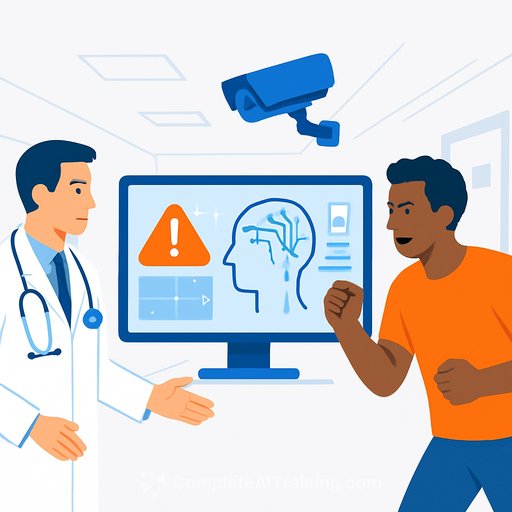Teladoc Health adds AI to Clarity to help curb hospital workplace violence
Teladoc Health is integrating new AI capabilities into its Clarity monitoring solution to help care teams spot and respond to threatening behavior inside hospitals. The system analyzes live video and audio to detect facial expressions, gestures, tone, and language patterns linked to aggression. When risk escalates, it alerts designated staff and security. It can also flag safety risks like someone aggressively tampering with medical equipment.
How it works
- Analyzes visual and audio cues for early signs of agitation or aggression.
- Scores the situation and triggers alerts when risk crosses a threshold.
- Routes notifications to the right team members for faster response.
- Complements existing tools that are often reactive (e.g., panic buttons).
Why this matters to health systems
Workplace violence is a recognized hazard in healthcare and continues to rise. OSHA classifies it as any act or threat of physical violence, harassment, intimidation, or disruptive behavior at work. Data trends are moving in the wrong direction and the operational impact is significant.
- Healthcare and social assistance had the highest counts and incidence rates for workplace violence in 2021-2022, with 41,960 nonfatal cases requiring days away from work, restriction, or transfer over two years, and 59 fatal injuries among practitioners and technical staff in 2023.
- Harassment reports among healthcare workers more than doubled from 6% in 2018 to 13% in 2022.
- Estimated total annual cost of hospital violence reached $18.27 billion in 2023.
See foundational context from OSHA and the CDC Vital Signs report.
What Teladoc is saying
"Healthcare workplace violence is a persistent and growing threat impacting care team safety, patient wellbeing, and health system operations," said Andy Puterbaugh, president of hospital and health systems at Teladoc Health. He noted that traditional tools rely on human vigilance, while this capability aims to prompt earlier intervention.
Availability
Hospitals and health systems can access Clarity with the new AI features in the first quarter of 2026 through Teladoc Health's partner development program.
Practical steps for hospital leaders
- Define use cases: ED, behavioral health, ICUs, visitor management, high-risk procedures, and equipment rooms.
- Clarify policies: Visible signage, consent where required, audio capture rules, data retention, and camera placement guidelines.
- Integrate alerts: Tie into nurse call, security dispatch, command centers, and EHR event logs for incident documentation.
- Pilot and tune: Start with a limited unit, adjust thresholds, measure precision/false alarms, and gather frontline feedback.
- Address bias: Evaluate performance across demographics and contexts; implement governance to review outcomes and appeals.
- Train staff: Pair alerts with de-escalation protocols and role-based drills (charge nurse, security, unit secretary).
- Measure impact: Track incident rate, time-to-response, injuries, staff turnover, patient throughput, and costs.
- Security and IT: Confirm data encryption, network load, interoperability, and incident response plans.
Key risks to manage
- False positives and alert fatigue: Use progressive alerting and clear triage workflows.
- Privacy and PHI exposure: Limit audio retention, control access, and audit logs regularly.
- Workforce trust: Engage staff councils and unions early; be transparent about intent and safeguards.
- Regulatory alignment: Map to HIPAA, state audio laws, and hospital accreditation standards.
Bottom line
Early warning and faster coordination can reduce harm, costs, and staff burnout. If your organization is evaluating safety tech, pair AI-driven detection with clear protocols, governance, and training. Start small, measure everything, and scale where the signal improves outcomes without creating noise.
If your teams need foundational AI skills to support deployments like this, explore role-based learning options at Complete AI Training.
Your membership also unlocks:






